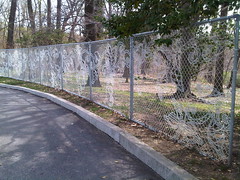
Demakersvan - Lace Fence, 2009
Approaching the center by car, one first meets with Demakersvan’s chain-link fence, which lines the driveway. The power of this work is how displacing it feels to have a simple chain-link fence transformed into something of beauty. We expect these fences to demarcate property lines, ensconce urban playgrounds, and even separate prisoners from the outside world. It is bracingly unexpected to see such delicate lacework seamlessly woven into the standard biased grid pattern.

Tord Boontje - Sofa, 2009
Tord Boontje has command of the three galleries within the center. He sets lace in reverse of its trajectory through industrialization, unearthing its handmade origins and then bounding straight ahead with these foundational principles into the age of high-technology. But do not pooh-pooh him for toeing the line of craft; design is truly at the forefront of what he has done. The tangled web of his sofa is lace under a powerful magnifying glass, while being simultaneously exploded and then reconstructed. His woven and knotted raffia palm leaf curtains, screens, and even garments are “green” design minus the present’s prevailing trendiness.

Cal Lane - 1000 Gallon Oil Tank, 2009
Finally, in the back yard, Cal Lane provides the show-stopper of the exhibition. I imagine her chosen oil tank being exhumed from some back yard, having spent decades as a workhorse in the service of home heating; it dreams of metamorphosing into something beautiful, rather than meeting its almost certain final destination at the scrap yard. Lane has made the tank into something that is both delicate and weighty, airy and earth-bound. Rust is a crucial component to her plan, continuing the tank’s transformation process via oxidization.
The quintessence of good design, all of these objects are beguilingly simple. But much of the action takes place upstairs, that is to say, within the minds of the artists who have imbued their works with intelligence and maturity, entrusting the audience to not only enjoy their visual handsomeness, but also decipher their nuanced levels of meaning.


Tord Boontje - Raffia Lace Curtain, 2009




No comments:
Post a Comment